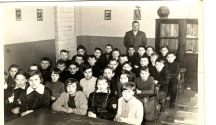They are similair in size to the US homes, but since they are made of brick or concrete blocks, they do not have insulation in the walls and they don't put siding on like in the US. There are usually 3-4 bedrooms and the upstairs usually has a balcony all made out of concrete. The wooden structure is used for trusses to make the roof where insulation is placed. The roofing material differs from that in the US in it that they don't have shingles. I have seen metal roofs becoming popular but mainly are made of cement (dachówka).
The steps are wooden inside and some homes in the country have a wood fire-stove where they cook on it and boil water. The door-knobs are not round like in the US but elongated. (My dog learned how to opened those kinds of doors by jumping up and placing one paw on the wall and the other flipping open the door-knob. Can't do that with the US doors.)
Wall-to-wall carpeting is not very popular, at least in the homes I was in. Floors are mainly wooden with a carpet on top. Bathrooms are similair except that the hot water is on the right marked with red and cold is on left marked with blue. Toilets look different, they have a "shelf" in the middle and are not filled with as much water as in the US because the water is below that little "shelf" (don't know how else to describe it) and to flush it you have to pull on a chain from above. But once again, not all tiolets are like that.
The kitchen. Many kitchens have small refrigerators, specially if you live in an apartment. But they are similair to the ones in the US, by having a compartment for eggs, shelves on the bottom, freezer on top, etc. Ovens and sinks are similair.
Furniture is very stylish and chic, some imported from neighboring European countries and many designs to choose from. TV's are the same, and unless you have a dish, you only get a few local channels. Washers and driers are similair, many still have small round-type to save space. Driers are not that popular and the clothes usually get hung in the bathroom to dry or on the balcony. If you live in the country they hang them on clothelines or over the fence. Some still wash clothes by hand.
The name for a Pole is Polak - like an American - but in the US it is used as a degrading remark and a source of jokes.
The steps are wooden inside and some homes in the country have a wood fire-stove where they cook on it and boil water. The door-knobs are not round like in the US but elongated. (My dog learned how to opened those kinds of doors by jumping up and placing one paw on the wall and the other flipping open the door-knob. Can't do that with the US doors.)
Wall-to-wall carpeting is not very popular, at least in the homes I was in. Floors are mainly wooden with a carpet on top. Bathrooms are similair except that the hot water is on the right marked with red and cold is on left marked with blue. Toilets look different, they have a "shelf" in the middle and are not filled with as much water as in the US because the water is below that little "shelf" (don't know how else to describe it) and to flush it you have to pull on a chain from above. But once again, not all tiolets are like that.
The kitchen. Many kitchens have small refrigerators, specially if you live in an apartment. But they are similair to the ones in the US, by having a compartment for eggs, shelves on the bottom, freezer on top, etc. Ovens and sinks are similair.
Furniture is very stylish and chic, some imported from neighboring European countries and many designs to choose from. TV's are the same, and unless you have a dish, you only get a few local channels. Washers and driers are similair, many still have small round-type to save space. Driers are not that popular and the clothes usually get hung in the bathroom to dry or on the balcony. If you live in the country they hang them on clothelines or over the fence. Some still wash clothes by hand.
The name for a Pole is Polak - like an American - but in the US it is used as a degrading remark and a source of jokes.
 PolishForums LIVE / Archives [3]
PolishForums LIVE / Archives [3]
